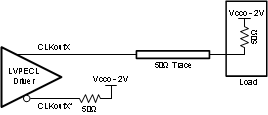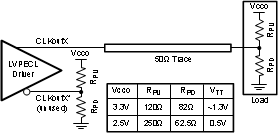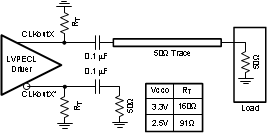SNAS577G February 2012 – August 2018 LMK00304
PRODUCTION DATA.
- 1 Features
- 2 Applications
- 3 Description
- 4 Revision History
- 5 Pin Configuration and Functions
- 6 Specifications
- 7 Parameter Measurement Information
- 8 Detailed Description
- 9 Application and Implementation
- 10Power Supply Recommendations
- 11Device and Documentation Support
- 12Mechanical, Packaging, and Orderable Information
Package Options
Mechanical Data (Package|Pins)
- RTV|32
Thermal pad, mechanical data (Package|Pins)
- RTV|32
Orderable Information
9.3.3 Termination for Single-Ended Operation
A balun can be used with either LVDS or LVPECL drivers to convert the balanced, differential signal into an unbalanced, single-ended signal.
It is possible to use an LVPECL driver as one or two separate 800 mV p-p signals. When DC coupling one of the LMK00304 LVPECL driver of a CLKoutX/CLKoutX* pair, be sure to properly terminate the unused driver. When DC coupling on of the LMK00304 LVPECL drivers, the termination should be 50 Ω to Vcco – 2 V as shown in Figure 36. The Thevenin equivalent circuit is also a valid termination as shown in Figure 37 for Vcco = 3.3 V.
 Figure 36. Single-Ended LVPECL Operation, DC Coupling
Figure 36. Single-Ended LVPECL Operation, DC Coupling  Figure 37. Single-Ended LVPECL Operation, DC Coupling, Thevenin Equivalent
Figure 37. Single-Ended LVPECL Operation, DC Coupling, Thevenin Equivalent When AC coupling an LVPECL driver use a 160-Ω emitter resistor (or 91 Ω for Vcco = 2.5 V) to provide a DC path to ground and ensure a 50-Ω termination with the proper DC bias level for the receiver. The typical DC bias voltage for LVPECL receivers is 2 V. If the companion driver is not used, it should be terminated with either a proper AC or DC termination. This latter example of AC coupling a single-ended LVPECL signal can be used to measure single-ended LVPECL performance using a spectrum analyzer or phase noise analyzer. When using most RF test equipment no DC bias point (0 VDC) is required for safe and proper operation. The internal 50 Ω termination the test equipment correctly terminates the LVPECL driver being measured as shown in Figure 38. When using only one LVPECL driver of a CLKoutX/CLKoutX* pair, be sure to properly terminated the unused driver.
 Figure 38. Single-Ended LVPECL Operation, AC Coupling
Figure 38. Single-Ended LVPECL Operation, AC Coupling